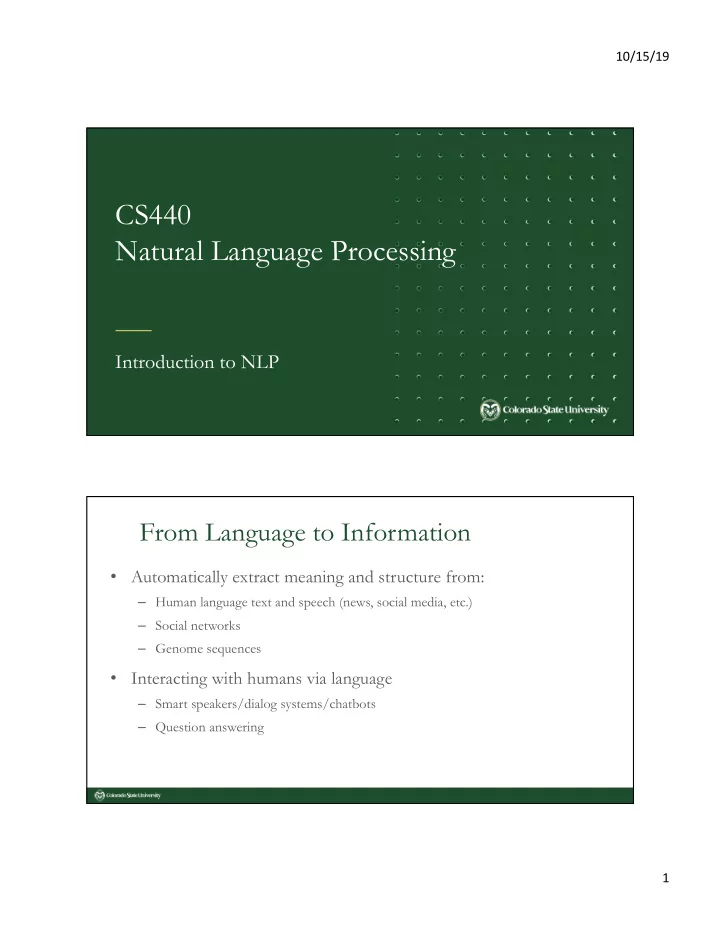

10/15/19 CS440 Natural Language Processing Introduction to NLP From Language to Information • Automatically extract meaning and structure from: – Human language text and speech (news, social media, etc.) – Social networks – Genome sequences • Interacting with humans via language – Smart speakers/dialog systems/chatbots – Question answering 1
10/15/19 NLP in industry Information Retrieval • 6,586,013,574 web searches every day (by one estimate) • Text-based information retrieval is thus likely the most frequently used piece of software in the world 2
10/15/19 Text Classification: Disaster Response • Haiti Earthquake 2010 • Classifying SMS messages Mwen thomassin 32 nan pyron mwen ta renmen jwen yon ti dlo gras a dieu bo lakay mwen anfom se sel dlo nou bezwen I am in Thomassin number 32, in the area named Pyron. I would like to have some water. Thank God we are fine, but we desperately need water. Extracting Sentiment • Lots of meaning is in connotation "connotation: an idea or feeling that a word invokes in addition to its literal or primary meaning." • Extracting connotation is generally called sentiment analysis 3
10/15/19 Extracting social meaning from language • Uncertainty (students in tutoring) • Annoyance – callers to dialog systems • Anger (police-community interaction) • Deception • Emotion • Intoxication Sentiment in Restaurant Reviews Dan Jurafsky, Victor Chahuneau, Bryan R. Routledge, and Noah A. Smith. 2014. Narrative framing of consumer sentiment in online restaurant reviews. First Monday 19:4 900,000 Yelp reviews online A very bad (one-star) review: The bartender... absolutely horrible... we waited 10 min before we even got her attention... and then we had to wait 45 - FORTY FIVE! - minutes for our entrees… stalk the waitress to get the cheque… she didn't make eye contact or even break her stride to wait for a response … 4
10/15/19 What is the language of bad reviews? • Negative sentiment language horrible, awful, terrible, bad, disgusting • Past narratives about people waited, didn’t, was he, she, his, her, manager, customer, waitress, waiter • Frequent mentions of we and us ... we were ignored until we flagged down a waiter to get our waitress … Computational Biology: Comparing Sequences AGGCTATCACCTGACCTCCAGGCCGATGCCC TAGCTATCACGACCGCGGTCGATTTGCCCGAC - AG G CTATCAC CT GACC T C CA GG C CGA -- TGCCC --- | | | | | | | | | | | | | x | | | | | | | | | | | T AG - CTATCAC -- GACC G C -- GG T CGA TT TGCCC GAC Sequence comparison is key to • Finding genes • Determining their function • Uncovering evolutionary processes This is also how spell checkers work! Slide stuff from Serafim Batzoglou 5
10/15/19 Personal Assistants Question Answering: IBM’s Watson 6
10/15/19 Why is language interpretation hard? Ambiguity • Resolving ambiguity is hard 7
10/15/19 Ambiguity Find at least 5 meanings of this sentence: I made her duck Ambiguity Find at least 5 meanings of this sentence: I made her duck • I cooked waterfowl for her benefit (to eat) • I cooked waterfowl belonging to her • I created the waterfowl statue she owns • I caused her to quickly lower her head or body • I recognized the true identity of her spy waterfowl 8
10/15/19 Ambiguity I made her duck Where is the ambiguity coming from? Part of speech : “duck” can be a noun or verb Meaning: “make” can mean “create” or “cook” Ambiguity Grammar : make can be: Transitive: (verb has a noun direct object) I cooked [waterfowl belonging to her] Ditransitive: (verb has 2 noun objects) I made [her] (into) [undifferentiated waterfowl] Action-transitive (verb has a direct object + verb) I caused [her] [to move her body ] 9
10/15/19 Making progress on this problem… • How we generally do this: – probabilistic models built from language data P(“maison” → “house”) high P(“L’avocat général” → “the general avocado”) low Models and tools • Language models • Word embeddings – vector/neural models of meaning • Machine Learning classifiers – Naïve Bayes – Logistic Regression – Neural Networks 20 10
10/15/19 Book Speech and Language Processing (3rd ed. draft) Dan Jurafsky and James H. Martin https://web.stanford.edu/~jurafsky/slp3/ Data Examples of interesting datasets... 11
Recommend
More recommend